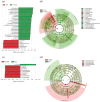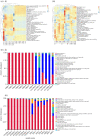Microbiota dysbiosis in honeybee (Apis mellifera L .) larvae infected with brood diseases and foraging bees exposed to agrochemicals
- PMID: 33614099
- PMCID: PMC7890499
- DOI: 10.1098/rsos.201805
Microbiota dysbiosis in honeybee (Apis mellifera L .) larvae infected with brood diseases and foraging bees exposed to agrochemicals
Abstract
American foulbrood (AFB) disease and chalkbrood disease (CBD) are important bacterial and fungal diseases, respectively, that affect honeybee broods. Exposure to agrochemicals is an abiotic stressor that potentially weakens honeybee colonies. Gut microflora alterations in adult honeybees associated with these biotic and abiotic factors have been investigated. However, microbial compositions in AFB- and CBD-infected larvae and the profile of whole-body microbiota in foraging bees exposed to agrochemicals have not been fully studied. In this study, bacterial and fungal communities in healthy and diseased (AFB/CBD) honeybee larvae were characterized by amplicon sequencing of bacterial 16S rRNA gene and fungal internal transcribed spacer1 region, respectively. The bacterial and fungal communities in disordered foraging bees poisoned by agrochemicals were analysed. Our results revealed that healthy larvae were significantly enriched in bacterial genera Lactobacillus and Stenotrophomonas and the fungal genera Alternaria and Aspergillus. The enrichment of these microorganisms, which had antagonistic activities against the etiologic agents for AFB and CBD, respectively, may protect larvae from potential infection. In disordered foraging bees, the relative abundance of bacterial genus Gilliamella and fungal species Cystofilobasidium macerans were significantly reduced, which may compromise hosts' capacities in nutrient absorption and immune defence against pathogens. Significantly higher frequency of environmentally derived fungi was observed in disordered foraging bees, which reflected the perturbed microbiota communities of hosts. Results from PICRUSt and FUNGuild analyses revealed significant differences in gene clusters of bacterial communities and fungal function profiles. Overall, results of this study provide references for the composition and function of microbial communities in AFB- and CBD-infected honeybee larvae and foraging bees exposed to agrochemicals.
Keywords: American foulbrood disease; agrochemical exposure; bacterial and fungal compositions; chalkbrood disease; honeybee.
© 2021 The Authors.
Conflict of interest statement
We declare we have no competing interests.
Figures






Similar articles
-
Honeybee-Specific Lactic Acid Bacterium Supplements Have No Effect on American Foulbrood-Infected Honeybee Colonies.Appl Environ Microbiol. 2019 Jun 17;85(13):e00606-19. doi: 10.1128/AEM.00606-19. Print 2019 Jul 1. Appl Environ Microbiol. 2019. PMID: 31003985 Free PMC article.
-
Feeding Honeybee Colonies with Honeybee-Specific Lactic Acid Bacteria (Hbs-LAB) Does Not Affect Colony-Level Hbs-LAB Composition or Paenibacillus larvae Spore Levels, Although American Foulbrood Affected Colonies Harbor a More Diverse Hbs-LAB Community.Microb Ecol. 2020 Apr;79(3):743-755. doi: 10.1007/s00248-019-01434-3. Epub 2019 Sep 10. Microb Ecol. 2020. PMID: 31506760 Free PMC article.
-
American foulbrood in a honeybee colony: spore-symptom relationship and feedbacks.BMC Ecol. 2020 Mar 6;20(1):15. doi: 10.1186/s12898-020-00283-w. BMC Ecol. 2020. PMID: 32143610 Free PMC article.
-
Involvement of secondary metabolites in the pathogenesis of the American foulbrood of honey bees caused by Paenibacillus larvae.Nat Prod Rep. 2015 Jun;32(6):765-78. doi: 10.1039/c4np00158c. Epub 2015 Apr 23. Nat Prod Rep. 2015. PMID: 25904391 Review.
-
The defensive response of the honeybee Apis mellifera.J Exp Biol. 2016 Nov 15;219(Pt 22):3505-3517. doi: 10.1242/jeb.143016. J Exp Biol. 2016. PMID: 27852760 Review.
Cited by
-
Bees just wanna have fungi: a review of bee associations with nonpathogenic fungi.FEMS Microbiol Ecol. 2023 Jul 21;99(8):fiad077. doi: 10.1093/femsec/fiad077. FEMS Microbiol Ecol. 2023. PMID: 37422442 Free PMC article. Review.
-
The Ascosphaera apis Infection (Chalkbrood Disease) Alters the Gut Bacteriome Composition of the Honeybee.Pathogens. 2023 May 19;12(5):734. doi: 10.3390/pathogens12050734. Pathogens. 2023. PMID: 37242403 Free PMC article.
-
Environmental Impacts and Behavioral Adaptations of Honeybees in Algeria: A Review of Apis mellifera intermissa and Apis mellifera sahariensis Characteristics.Insects. 2025 Jun 11;16(6):617. doi: 10.3390/insects16060617. Insects. 2025. PMID: 40559047 Free PMC article. Review.
-
Aspergillus-bees: A dynamic symbiotic association.Front Microbiol. 2022 Sep 7;13:968963. doi: 10.3389/fmicb.2022.968963. eCollection 2022. Front Microbiol. 2022. PMID: 36160228 Free PMC article. Review.
-
Genotypic variation in floral volatiles influences floral microbiome more strongly than interactions with herbivores and mycorrhizae in strawberriesd.Hortic Res. 2022 Jan 5;9:uhab005. doi: 10.1093/hr/uhab005. Hortic Res. 2022. PMID: 35141759 Free PMC article.
References
-
- Chapman NC, Oldroyd BBP. 2010. Worker reproductive parasitism and drift in the western honeybee Apis mellifera. Behav. Ecol. Sociobiol. 64, 419–427 (10.1007/s00265-009-0858-7) - DOI
Associated data
LinkOut - more resources
Full Text Sources
Other Literature Sources

